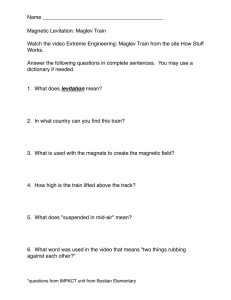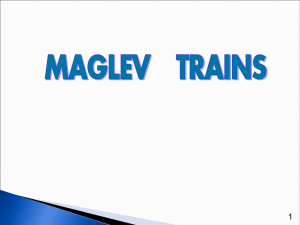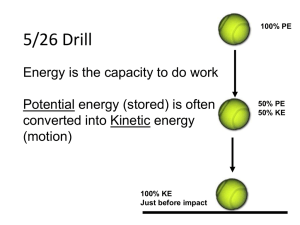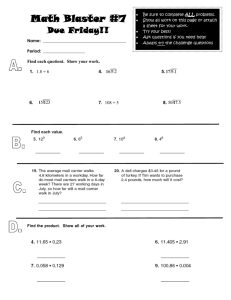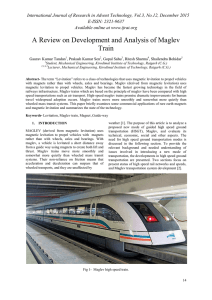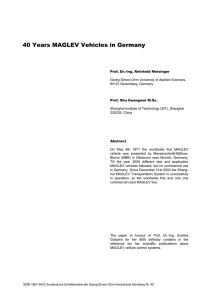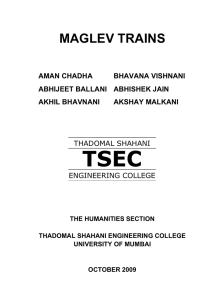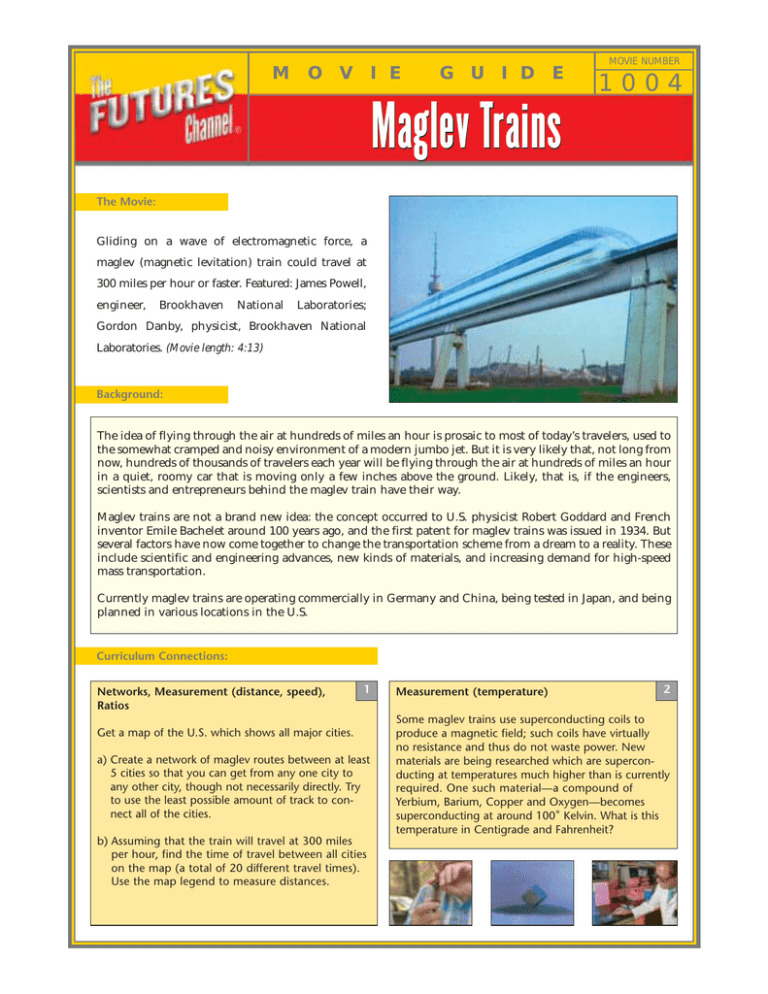
M O V I E
G U I D E
MOVIE NUMBER
1004
Maglev Trains
The Movie:
Gliding on a wave of electromagnetic force, a
maglev (magnetic levitation) train could travel at
300 miles per hour or faster. Featured: James Powell,
engineer,
Brookhaven
National
Laboratories;
Gordon Danby, physicist, Brookhaven National
Laboratories. (Movie length: 4:13)
Background:
The idea of flying through the air at hundreds of miles an hour is prosaic to most of today’s travelers, used to
the somewhat cramped and noisy environment of a modern jumbo jet. But it is very likely that, not long from
now, hundreds of thousands of travelers each year will be flying through the air at hundreds of miles an hour
in a quiet, roomy car that is moving only a few inches above the ground. Likely, that is, if the engineers,
scientists and entrepreneurs behind the maglev train have their way.
Maglev trains are not a brand new idea: the concept occurred to U.S. physicist Robert Goddard and French
inventor Emile Bachelet around 100 years ago, and the first patent for maglev trains was issued in 1934. But
several factors have now come together to change the transportation scheme from a dream to a reality. These
include scientific and engineering advances, new kinds of materials, and increasing demand for high-speed
mass transportation.
Currently maglev trains are operating commercially in Germany and China, being tested in Japan, and being
planned in various locations in the U.S.
Curriculum Connections:
Networks, Measurement (distance, speed),
Ratios
1
Get a map of the U.S. which shows all major cities.
a) Create a network of maglev routes between at least
5 cities so that you can get from any one city to
any other city, though not necessarily directly. Try
to use the least possible amount of track to connect all of the cities.
b) Assuming that the train will travel at 300 miles
per hour, find the time of travel between all cities
on the map (a total of 20 different travel times).
Use the map legend to measure distances.
Measurement (temperature)
2
Some maglev trains use superconducting coils to
produce a magnetic field; such coils have virtually
no resistance and thus do not waste power. New
materials are being researched which are superconducting at temperatures much higher than is currently
required. One such material—a compound of
Yerbium, Barium, Copper and Oxygen—becomes
superconducting at around 100˚ Kelvin. What is this
temperature in Centigrade and Fahrenheit?
3
Measurement (speed, acceleration)
A maglev train begins a trip by accelerating from an initial speed of zero to its operating speed of, say, 150
meters per second.
Suppose that the rate of acceleration is 5 meters per
second of speed increase each second. How long would
it take to reach operating speed? You may wish to solve
this problem by extending this table:
# of seconds after
beginning
Speed
0
1
2
3
4
0 meters/second
5 meters/second
10 meters/second
15 meters/second
etc.
4
Ratios, Measurement (transportation)
The amount of use of any form of mass transportation
is measured in passenger-miles. For example, if there
are 3 people in an automobile on a trip of 10 miles, that
would be 30 passenger-miles. If there are 400 people in
on a maglev train that travels 150 miles, that counts as
60,000 passenger-miles.
An automobile gets an average of around 20 passengermiles for the energy in a gallon of gasoline (roughly
124,000 BTU’s of energy). The Transrapid, a maglev
train in Germany, is said to be three times as efficient. If
that ratio applies, how much energy, measured BTU’s,
is required by the Transrapid to carry 300 passengers
a distance of 50 miles?
5
Algebra (solving equations)
It takes energy to get a maglev train up to speed; the amount of energy needed to reach a speed of v meters per
second, starting from zero, is given by this formula
E = 1⁄2 mv 2
E = energy in joules
m = mass in kilograms
v = velocity in meters per second
a) How many joules of energy are required to bring a train with a mass of 20,000 kilograms to a velocity of 150
meters/second?
b) Suppose the same amount of energy were used on a train with a mass of 15,000 kilograms. What velocity would
it reach?
6
Algebra (functions, linear equations)
In this experiment, students will build a magnetic testing device and use it to learn more about how magnets can
levitate heavy objects.
Students should work in teams of 4 members each. Each team will need these materials:
A few 4 x 6 index cards
Four small, flat magnets or magnetic strips
Masking tape
30 pennies
Step 1: Tape one of the flat magnets at each corner of a 4 x 6 index card. The magnets must be taped so that all
have the same pole—north or south—pointing up.
magnet
tape (wraps around other
side of index card)
N
S
N
N
S
S
N
S
2. Fold the card exactly in half across its width, so that the magnets oppose each other. Crease the fold sharply.
3. To complete the testing device, tape the bottom of the card to a corner of a table or desk (this will make it
easier to measure the separation between the top and bottom of the card):
Table or desk
Card taped at corner
of desk
4. Next you are going to be stacking weights on the top of the card and measuring the changing distance
between the top and bottom half of the card. Before carrying out the experiment, write down what you
think will happen as you add more weight, and explain why.
5. The weights you will use will be stacks of 3 pennies. First, make 10 such stacks by taping 3 pennies together
for each stack. (Note: Masking tape is recommended for both these weights and taping the magnets to the
cards, because the tape has a slightly rough surface which will prevent the pennies from sliding off the top
of the card.)
6. Measure the distance from the top to the bottom of the card:
Measure this distance
in millimeters
7. Put two stacks of pennies on the top of the card, and measure the distance again.
8. Add more stacks of pennies, two at a time, each time measuring the indicated distance.
9. Make a table which presents the information you gathered, with “number of pennies” in one column and
“distance” in the other column. Then graph the data in an xy coordinate system, with “number of pennies” as
the independent variable and “distance” as the dependent variable.
10. Answer these questions:
a) Does the relationship between “number of pennies” and “distance” seem to be a function?
b) Is it a linear function? Explain your answer.
c) How many pennies would be required to close the distance to 1 millimeter? Explain your answer.
If you enjoyed this Futures Channel Movie, you will probably also like these:
Flights of Imagination,
#1003
Aeronautical inventor Paul MacCready describes how he built a humanpowered airplane.
Roller Coasters, #1008
Designing safe roller coasters requires an understanding of forces.
The New York City
Subway, #5005
The New York City subway moves millions of people every day, thanks to
the skills of a team of remarkable people.
THE FUTURES CHANNEL • 4801 Wilshire Blvd., Suite 210, Los Angeles, CA 90010 • www.thefutureschannel.com
Copyright © 2004 The Futures Channel, Inc. All Rights Reserved. No portion of this document may be copied or transmitted in any form, physical or electronic, without
express written permission from The Futures Channel.

